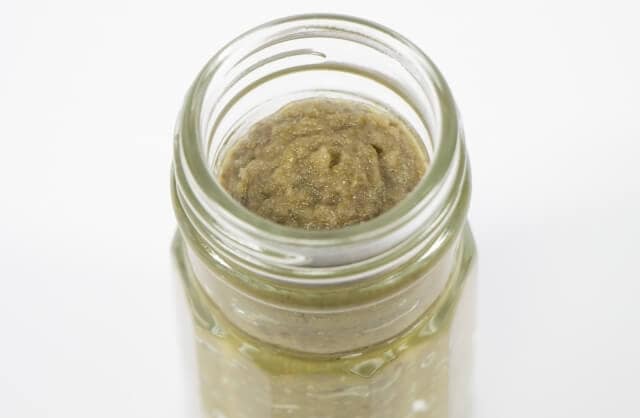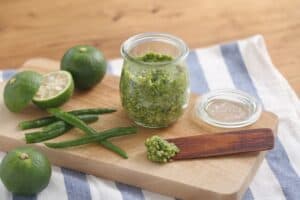Despite its simple name, Yuzu Kosho boasts a fascinating backstory and a wide range of uses in Japanese cuisine. Join us as we explore the origins, versatility, and unique flavors of Yuzu Kosho, and uncover why it has become a beloved staple in kitchens across Japan. Let’s dive in and discover the delicious possibilities of this intriguing seasoning!
What is Yuzu Kosho?

Yuzu kosho is a Japanese condiment made from yuzu citrus zest, chilli peppers, and salt. Locals make this by peeling the skin of a yuzu, finely chopping the skin, and then rubbing it with fresh green chili peppers and salt. Known for its vibrant flavor profile, combining the citrusy aroma of yuzu with the spicy kick of chili peppers. Often used as a seasoning or a condiment to add depth and complexity to various dishes, including soups, grilled meats, seafood, and noodles. It can be found in both green and red varieties, with the green being made from green chili peppers and the red from red chili peppers.
Yuzu kosho History

“Yuzu Gosho” is a popular seasoning from the Kyushu region, with one theory suggesting its origin around Mt. Hiko in Fukuoka Prefecture. Mt. Hiko, also known as Mt. Shugen, was home to many mountain priests who used yuzu, abundant in the mountains, to make medicine, possibly sparking the creation of Yuzu Gosho. Despite its name, Yuzu Gosho doesn’t contain regular pepper but instead uses chili pepper, which is commonly referred to as pepper in the Kyushu region. Unlike Western pepper, which is the common pepper, Yuzu Gosho uses either green or red chili peppers. Green chili peppers are typically spicier, while red ones have a stronger aroma, allowing for choice based on personal preference.
When is the right time to eat Yuzu Gosho?

Eating lessons with Yuzu come with unique opportunities tied to the changing seasons. As autumn and winter unfold, Yuzu gradually ripens, transitioning from green to yellow. To capture its vibrant flavors, it’s best to use green yuzu before it fully ripens. Green peppers, which are in season from July to September, align perfectly with green yuzu. This seasonal produce is often prepared in small batches, frozen, and then enjoyed throughout the year. Yuzu is particularly popular as a condiment for hotpots, udon noodles, sashimi, and as a flavor enhancer in various dishes, adding a refreshing zest to every bite.
Why is it called “Yuzu Pepper” when there is no pepper in it!?

The name “Yuzu Kosho” stems from some regions in Kyushu where chili peppers are referred to as “kosho.” Locally, it’s a common term encompassing both yuzu and pepper (chili pepper). This versatile seasoning finds its way into various culinary delights, serving as a condiment for hot pot dishes and sashimi or adding a secret kick to pasta recipes. Additionally, there’s a red version of yuzu pepper made with yellow yuzu and red chili pepper for those seeking a different flavor experience.
Dishes using Yuzu kosho
Squid yuzu pepper pasta

A pasta dish with plenty of toppings, including squid, asparagus, and king king mushrooms. Yuzu pepper gives it a refreshing flavor.
Pork sesame yuzu pepper grilled udon

Fried udon noodles made with pork and cabbage. This is a refreshing dish with the flavor of yuzu and pepper.
Soba peperoncino with yuzu pepper flavor

This is a slightly different peperoncino made with buckwheat noodles. Even though soba tends to be eaten in the same way, you can enjoy it in a different way by adding yuzu and pepper as an accent.
Yuzu kosho FAQ
- Is Yuzu Kosho suitable for people with dietary restrictions?
Generally, Yuzu Kosho is suitable for many dietary restrictions as it typically contains only natural ingredients like yuzu zest, chili peppers, and salt. However, individuals with specific dietary concerns, such as those with allergies to citrus or chili peppers, should exercise caution and check the ingredients list to ensure it meets their dietary needs.
- Can Yuzu Kosho be used as a substitute for other citrus-based condiments like lemon or lime zest?
Yes, Yuzu Kosho can serve as a flavorful substitute for lemon or lime zest in many recipes. Its distinctive citrusy aroma and tangy taste can add a unique dimension to dishes that call for citrus zest.
Yuzu kosho Recipe

Yuzu kosho Ingredients
| Ingredients of Yuzu kosho for | Measurements |
|---|---|
| Green yuzu peel | 80g |
| Green chili peppers (seeds removed) | 80g |
| Salt | 16g |
How to make Yuzu kosho?
Remove the damaged skin from the yuzu and grate only the green part on a grater.
Wearing rubber gloves, remove the stems from the chili peppers, cut them in half lengthwise, and remove the seeds and membranes. Chili peppers are very strong, so be careful not to touch your face or rub your eyes while doing this.
Chop the chili peppers with a knife and blend in a blender until smooth. If the mixer doesn’t work properly, add a little squeezed yuzu juice.
Mix and put some salt, pack it in a clean container, and it’s ready.
You can make red yuzu pepper using yellow yuzu peel and red chili pepper.
Some recommendation of Yuzu kosho
Yuzunoka Honpo’s Yuzunoka

The moment you open the bottle, you can smell the soft scent of yuzu. When you eat it, the aroma quickly leaves your nose, leaving behind a refreshing spiciness. It has a slightly salty taste and is not too spicy, so it can be used as a seasoning to add the aroma of yuzu, saltiness, and spiciness. It may not be spicy enough for people who like spicy food, but if you’re looking for the scent of yuzu, this is the best
Kawahara Foods’ Hizen Mifukuan Yuzu Kosho

It has a sweet aroma similar to marmalade, with a hint of salt and spiciness. You can enjoy the natural sweetness and saltiness of yuzu in a good balance. When added to a duck pot, the natural sweetness brings out the rustic flavor of the duck meat, while the subtle saltiness and marmalade-like aroma gently brighten the aftertaste.
Kawazu Family Carefully Made Grain Yuzu Pepper

It has a more sour and sour aroma than the skin of a yuzu fruit, and has a refreshing taste similar to a mandarin orange. When you bite into the coarsely chopped and kneaded skin, you can feel the sourness and refined saltiness, followed by the bitterness of the fruit. Average spiciness and moderate saltiness. It is easy to use as a seasoning and goes well with olive oil and paprika.
Takeaway

Next time you find yourself in Japan, be sure to seek out the delightful flavors of Yuzu Kosho. Whether adding a kick to your noodles or bringing a burst of zest to your seafood, this versatile condiment promises to elevate your culinary experience. With its rich history and wide range of applications, Yuzu Kosho is a true gem of Japanese cuisine waiting to be discovered.
You can check some Japanese condiments that we know you would like to try too.
















Comments